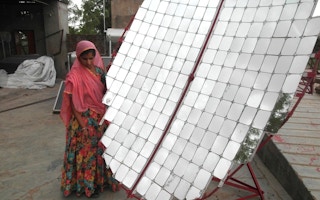India’s contribution to global carbon emissions was only 7 per cent last year, yet there are fears being expressed in the western world that rapid population growth and development will mean this vast country will soon be a major polluter − like its neighbour, China.
For the world, it is a continued worry that if the country soon to have the largest population in the world develops − as China has − by burning coal, climate change will surely get out of control.
No commitments on climate change have so far been made by India, as it waits to see what the developed countries offer to prove they are serious about aid, technology transfer, and targets to reduce their own emissions.
Carbon tax
But while priority in India has been given to development − particularly providing electricity for the millions who live without it − and tackling poverty, the newly-elected government has made a promising start on recognising the importance of climate change.
It has a new energy policy centred on an ambitious increase in solar power capacity − from the current 20,000 megawatts to 100,000 MW in five years. There is a Rupees 5 billion ($80 million) budget this year alone for “ultra mega” solar projects. And a carbon tax on coal has also been doubled for the purpose of subsidising solar and other renewables.
Prakash Javadekar, India’s Environment, Forests and Climate Change minister, said before heading for the UN climate change conference being held in Lima, Peru: “This game-changer energy mix will give us enhanced energy efficiency and save 50 million tonnes of coal. That’s a huge contribution to the world, and will affect our emissions. We will walk the clean water, clean air, clean power path.”
“
We are not going on the ‘business as usual’ path − although we are entitled to it. Both solar and coal power will increase, but that is our energy mix. We are doing our own actions under domestic legislations
Prakash Javadekar, India’s Environment, Forests and Climate Change minister
There have been reports about a possible announcement next month – when US president Barack Obama visits New Delhi − of the year in which India intends its greenhouse gas emissions to peak.
However, Javadekar refused to set a timeline, despite the apparent pressure after the US-China joint declaration that the US will reduce emissions by 2025 and China’s will peak by 2030. All countries are supposed to inform the UN Framework Convention on Climate Change (UNFCCC) by March 2015 of their action plans for emission reductions.
Javadekar said India is putting in place several action plans for achieving the Intended Nationally Determined Contributions as part of the 2015 agreement. But he made clear that the “peaking year” will not be the benchmark set at Lima; it will be “India’s contribution” − and will be much more than expected.
India, which is expected to surpass China’s current 1.3 billion population by 2030, has always defended its position, as its emissions are less than 2 tonnes per capita, compared with about 7.2 tonnes in China and 16.4 tonnes in the US.
“Our growth cannot be compromised,” Javadekar said. “We have the right to develop, and our priority is to eliminate poverty and meet the aspirations.”
Objections raised
Asked how India will address objections raised by developed countries to it digging more dirty coal, despite its ambitious solar programme, Javadekar insisted: “We are not going on the ‘business as usual’ path − although we are entitled to it. Both solar and coal power will increase, but that is our energy mix. We are doing our own actions under domestic legislations.”
There is a rift at the Lima talks between the developed and the developing countries on the issue of capitalisation of the Green Climate Fund under the 2015 Paris agreement, and this has already seen the G77 group of nations banding together.
Sunita Narain, director general of the Delhi-based Centre for Science and Environment thinktank, referred to this in talking about the “politics of climate change”, and how the global south is being short-changed by the global north.
She said climate change talks are about achieving clean economic growth, but, 25 years after talks began, the world is “still procrastinating and finding excuses not to act”.










